18 – 19 September 2022
It’s Sunday and after a hearty breakfast we board our large and comfortable bus and drive to Issyk-Kul Lake. The road travels west within the valley before rounding the mountains in a southerly direction and looping east around the mountain to go up the next valley and the northern shore of the lake. All the while we are bracketed by tall mountains. The bus travels about 100 miles but takes us over three hours. Passage is slow.
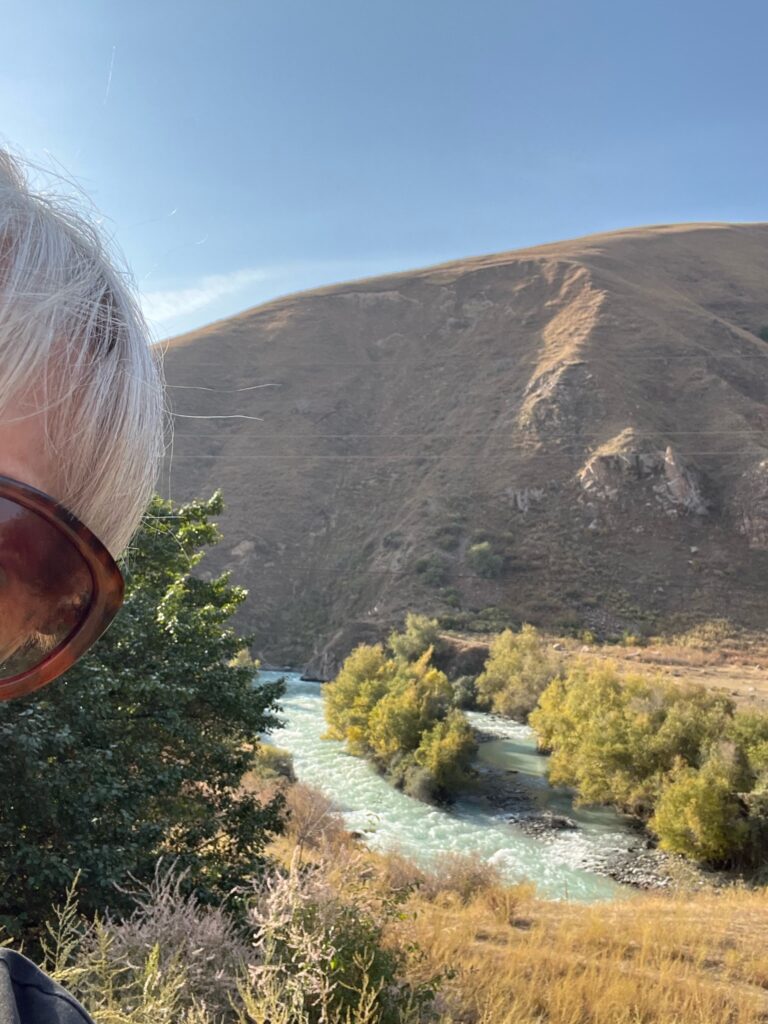
A highlight of the drive is a quiet spot along the road where we walk above the rushing Chon-Kemin River. There are few cars and only the occasional curious cow. The river, used for rafting in the spring and summer, is a bright turquoise, a result of the glacial melt in the mountains. The morning air wafts cool as the sun peaks above the mountaintops. When we are picked up by the bus, our guide rewards us with treats and we continue our drive.
Today is one of those days that leads you to fall in love with a country.
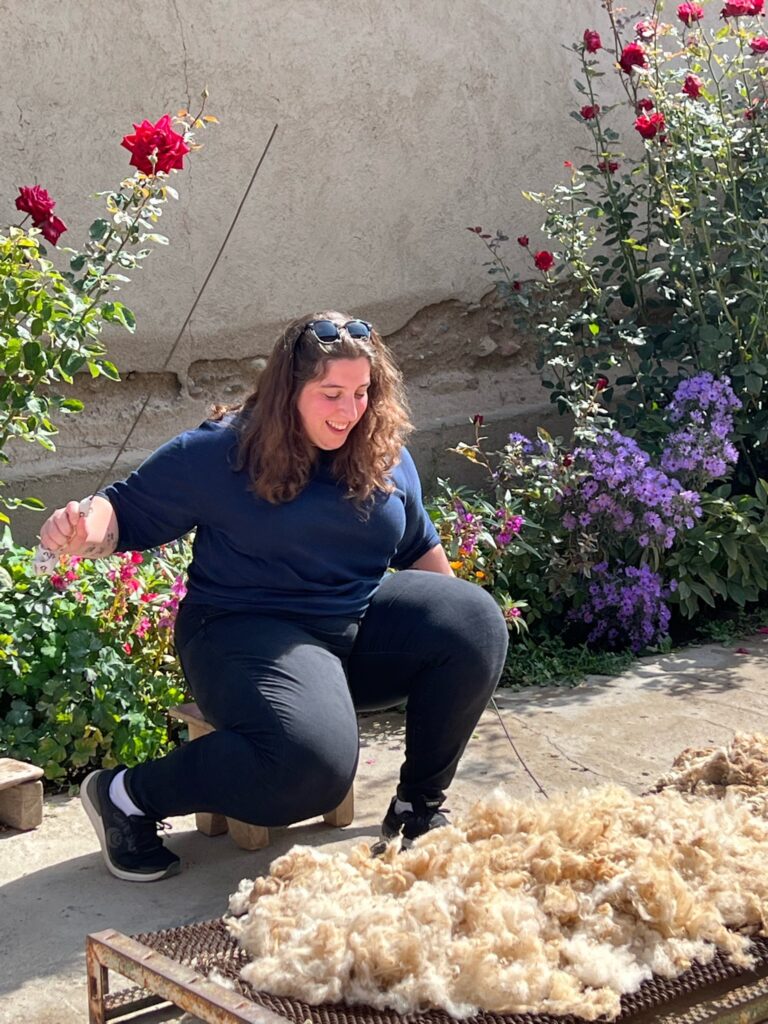
We drive through arid hills, gorges, along rivers and rocky canyons, past small villages and farms, to stop in the little village of Tamchy for a demonstration on how felt is made. This is something few people sit around the dinner table and discuss. I found it interesting. Felt is something that was just there; now I know how it is made.
Later, we arrived at spectacular Issyk-Kul Lake, the Pearl of Tian-Shan. Surrounded by spectacular mountains, filled with frigid clear waters, this lake is one of the most popular tourist spots in Kyrgyzstan. It s a higher altitude here, over 5000 feet. Hotels and resorts dot its northern shore and the best beaches lie in our destination city of Cholpon-Ata. I imagine it’s rustic atmosphere will be fleeting as more and more tourism affects it. Kyrgyzstan has little to export so the importation of tourist is important for the economy.
Issyk-Kul, or “warm lake” as it doesn’t freeze, is considered an endorheic lake, one with a limited drainage basin which does not typically have a source of outflow for its waters. The saline lake is fed by glaciers and some 120 rivers which flow into the lake; water exits through evaporation. The lake is the 7th deepest in the world and the 2nd largest mountain lake in the world (think Titicaca). In spite of a closed basin, the overall surface area of the lake is alarmingly shrinking. Think climate change and poor environmental decisions, mostly by the Russians.

A highlight of the day is a short cruise and lunch on the lake. After, we visit the Petroglyphs Open Air Museum, a UNESCO site. There were lots of big stones laying around and our guide was expert in pointing out the petroglyphs, otherwise I might have walked right past. Designs ranged from ibex to snow leopards, which used to be plentiful. These drawings are from the second millennium BC and into the Middle Ages. There are also tombstones dated from the early 1300s and some of the world’s oldest coins were pulled from the lake. All a reminder that Genghis Khan probably slept here.
Conquering the world on horseback is easy; it is dismounting and governing that is hard. ― Genghis Khan
Two interesting points about Issyk-Kul, one conjecture, one real. Some historians think the lake was the point of origin for the Black Death of the 1300s as perfect conditions existed along this Silk Road stopover in route between Asia and Europe. That probably has no way to be proven. However, the Russians did use this lake as a submarine and torpedo test range during their stay. For a few million dollars, the Russian Navy have extended these test facilities. So, ignore any big booms in the otherwise peaceful natural setting.
We lodge at Hotel Tri Korony, Three Crowns, in Cholpon-Ata, located on the lake shore with views of the mountains, lake and beaches. Once again, we dine on plentiful and delicious food, our guide spoils us with treats. Tonight, it is Kyrgyz brandy tasting.
We awake to a new day…bright, warm, pleasant. There were thunder storms last night, or Russian artillery tests. This morning, an added layer of snow dusts the mountains. Peaks range from 12 – 16,000 feet and glaciers can be seen. There is a haze but the views are beautiful and the hotel gardens are spectacular with blooming roses of all colors. Snow leopards once roamed these mountains but senseless hunting eradicated the species. Now the peaks form isolating borders between here and China, Mongolia, Tajikistan, Pakistan, Kazakhstan. The Silk Road passed through here for centuries.
We pass a huge stadium built for Buzkashi, the goat pulling competitions. It is longer than a football stadium and clearly indicates how important the sport is. All 14 regions of Kazakhstan have professional teams.
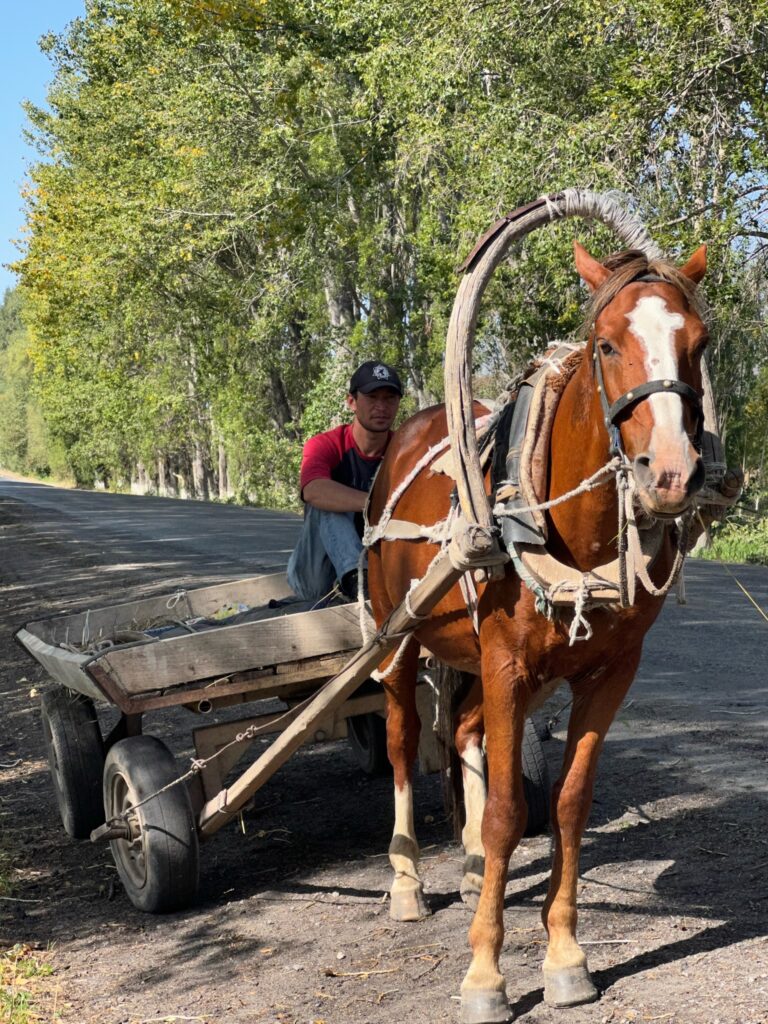
Our drive, always long because of distances and speed limits, and the occasional cow, is informative. We learn that the fields of potatoes formerly grew poppy. Those working to dig the new cash crop, potatoes, earn about $12 a day. Most of it involves back-bending hand work. An occasional tractor is seen. A few horse carts move along the roads but the most common sight is the herder and his horse. Evidence of the typical Soviet pull out remain in the remains of abandoned and derelict factories and grain elevators. Our pit stops are well-planned as most toilets are squat but clean. Look for the handicap toilet as most times it is western style. Monuments honoring the local “lord” dot the landscape, some small others reminiscent of Genghis Khan himself.
Our bus takes us, slowly as speed limits are mostly 40 to 60 km an hour, to the eastern shore, along the “Russian rental property” of the Karabulan Peninsula, to the town of Karakol. The border with China is not that distant. Karakol is the provincial capital of the region and the fourth largest city in Kyrgyzstan. We are here to visit, among other sites, the Przhevalsky Museum.
Nicholay Przhevalsky was a Russian explorer who died of typhoid here in 1888 while he prepared an expedition across China to Tibet. Karakol was renamed Przhevalsky until locals demanded a return to Karakol in 1921. Stalin renamed it again in honor of the Russian explorer until the Soviets departed and all those signs were once again changed to Karakol in 1991.
Przhevalsky organized and carried out several expeditions to study flora and fauna while mapping routes over the mountains, including ranges of the Tibet Mountains. When looking at a map of his treks, I realize this man walked a lot, each time trying to reach Tibet and each time failing. Most often China stopped him from entering, sometimes within sight. Imagine walking 1000 miles only to be turned back. He collected an enormous zoological collection during his trips through Mongolia and China. He is also recognized for breeding the small horse of the Tibetan steppes which later was named for Przhevalsky.
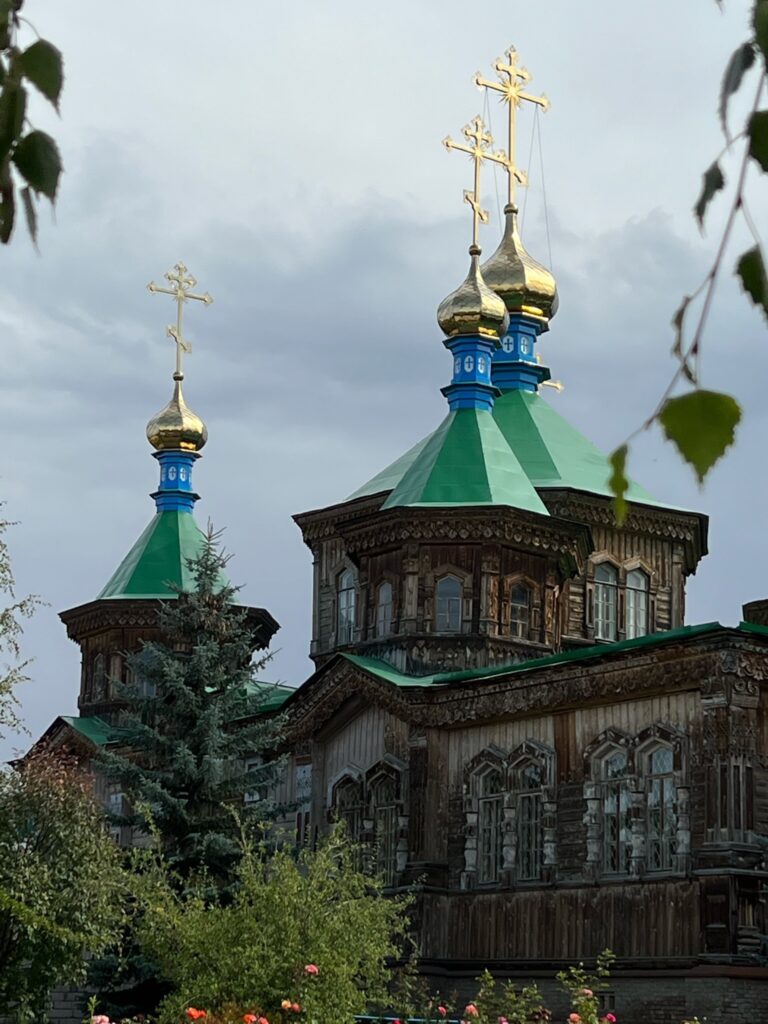
I enjoy visiting churches and mosques and Karakol has a few. The Russian Orthodox Cathedral was built in 1872 when the Russians were garrisoned in town. Destroyed later by an earthquake, it was rebuilt by 1895, mostly of wood. Tragically, during the anti-Russian protests in 1916, its monks were murdered. After utilitarian uses under the Soviets, it was restored to its original purpose as a church after 1991.
Two quick stops were made in Karakol. We visited a small music school for ages 8-14. Music and art is supported by the state. Students attend three times a week after regular school. Another stop is made to enable us to walk through the local market. It features the typical array of colorful produce, breads, and clothing. But one could describe this as a “container market” as almost every seller is housed in old metal shipping containers, recycled from China. One sees hundreds of containers used for businesses, housing, and storage.
The Dungan Mosque is quite beautiful and gets its name from the ethnic Dungan community of northwestern China who fled religious persecution. In 1910, its wooden cornice and multi-tiered tower were expertly carved depicting pomegranates, grapes and other fruit. Again, no nails were used by the craftsmen. The Russians used it as a storehouse for a time but in 1947 the Muslim community took possession. Its blue color is stunning against the blue sky.
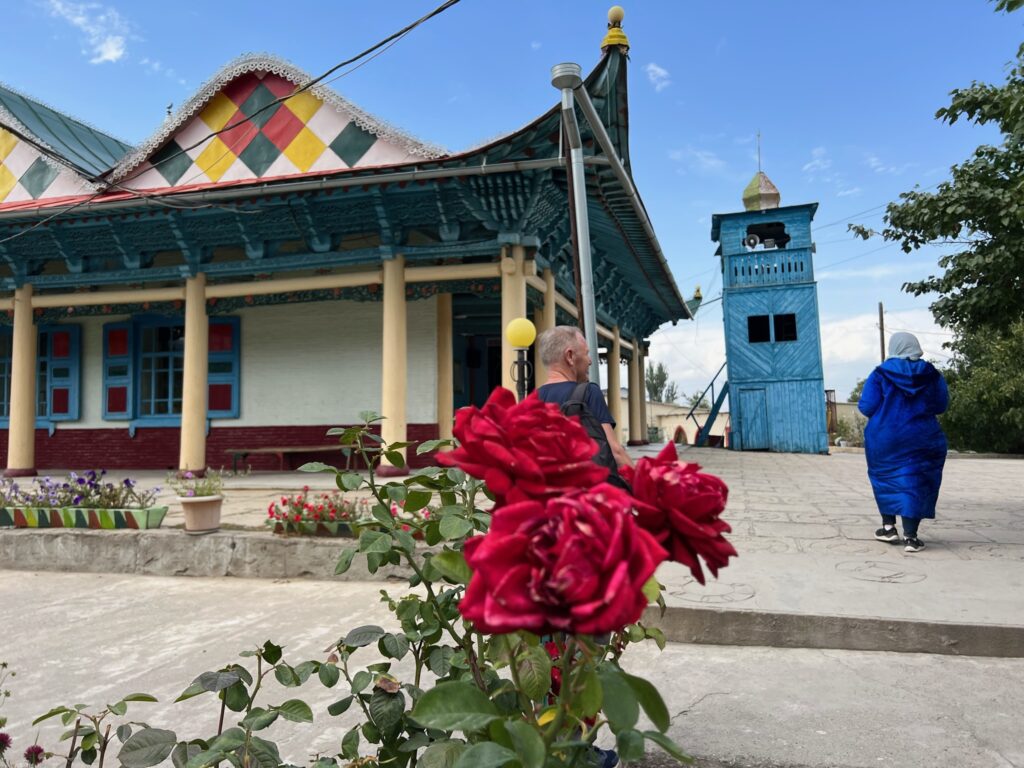
We return to our hotel on the north side of the lake, enjoying the lovely views and serene mountains. Thunder clouds once again hang over the peaks. Tomorrow, we head to Bishkek, capital of Kyrgyzstan.
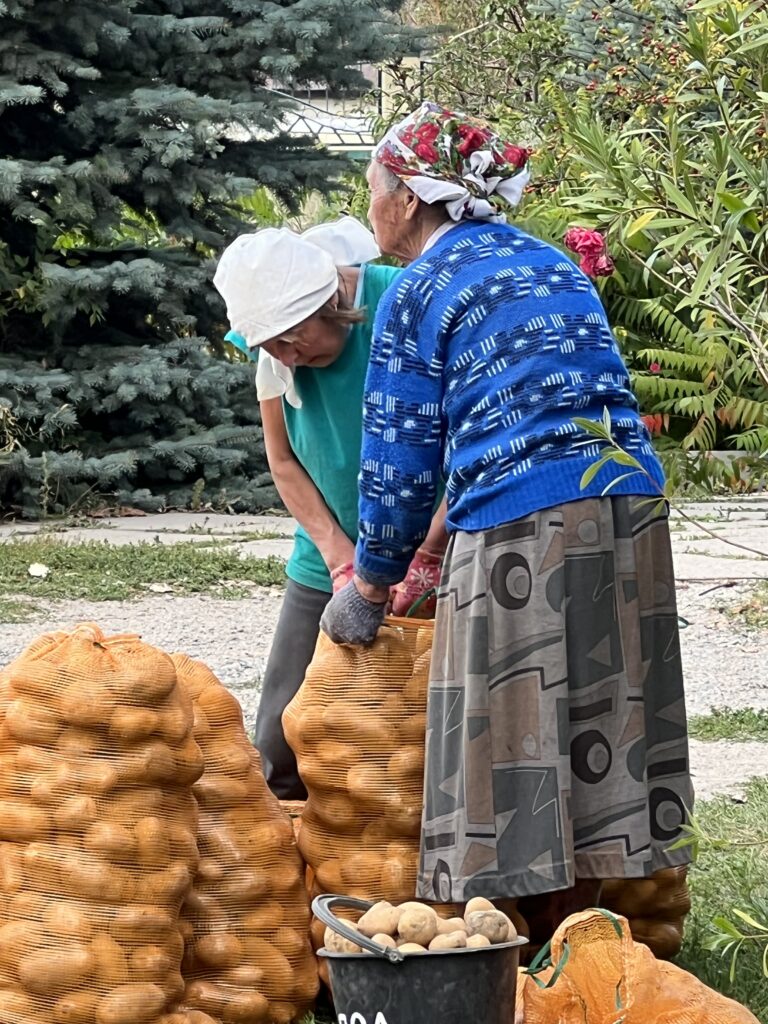
0 Comments